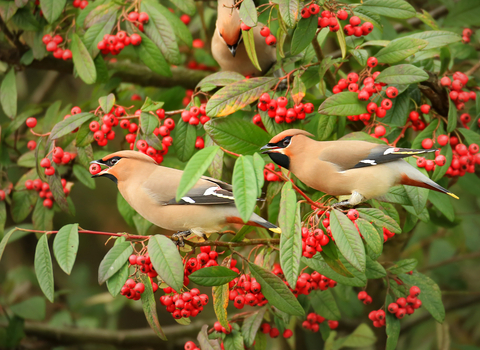
©Jon Hawkins Surrey Hills Photography
Waxwing
The waxwing is a colourful winter visitor. It can often be spotted in large flocks in berry-laden bushes in towns, car parks and gardens.
Scientific name
Bombycilla garrulusWhen to see
October to MarchTop facts
Stats
Length: 18cmWingspan: 34cm
Weight: 63g
Classified in the UK as Green under the Birds of Conservation Concern 5: the Red List for Birds (2021).
About
A starling-sized bird, the waxwing is one of the UK's most exotic-looking birds, with a large, orangey-pink crest. It does not breed in the UK, but is a winter visitor from Northern Europe and can be spotted in flocks on bushes full of berries - it isn't fussy where the bushes are and frequents towns, car parks and gardens. Waxwings prefer rowan and hawthorn berries, but can be enticed with hung-up apples. Sudden invasions of large numbers of waxwings (called 'irruptions') occur when the berry crops fail in Northern Europe.What to look for
The waxwing has a pink crest and breast, a black mask and throat, a grey rump, a black tail that is tipped with bright yellow, and yellow-and-white markings on its wings.Where to find
A rare winter visitor which can turn up anywhere, particularly in the north and east of the country.Did you know?
Waxwings tend to prefer eating red berries to orange berries; but they will choose the latter over yellow and white ones. This pattern is seen in many other berry-eating birds. One downside of eating so many berries is that the birds sometimes become a bit intoxicated by fermenting fruit.Watch
Waxwings (https://vimeo.com/453714136)
Waxwings by Jack Perks
